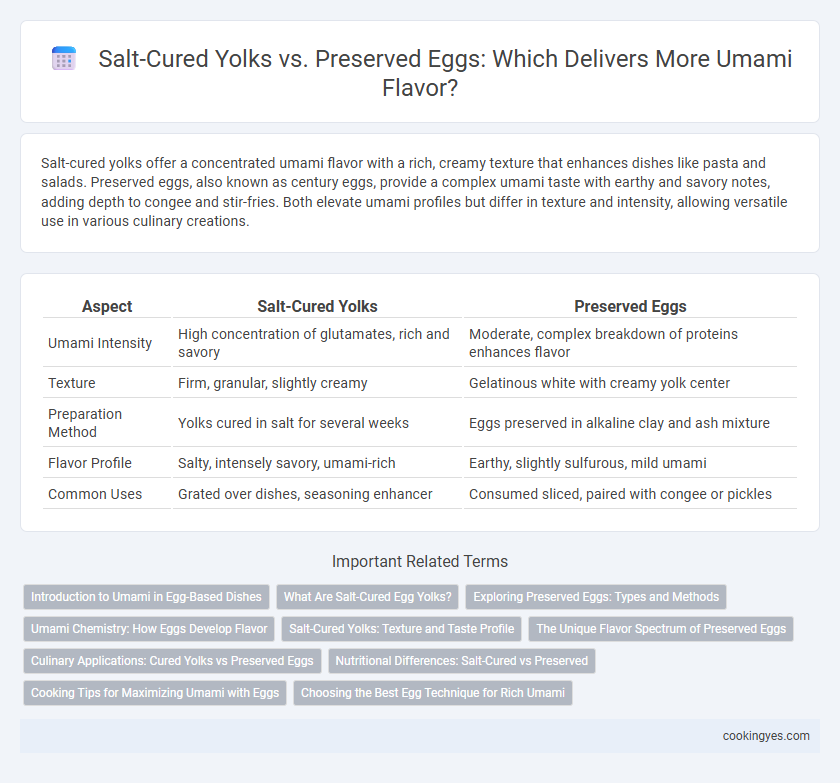Salt-cured yolks offer a concentrated umami flavor with a rich, creamy texture that enhances dishes like pasta and salads. Preserved eggs, also known as century eggs, provide a complex umami taste with earthy and savory notes, adding depth to congee and stir-fries. Both elevate umami profiles but differ in texture and intensity, allowing versatile use in various culinary creations.
Table of Comparison
| Aspect | Salt-Cured Yolks | Preserved Eggs |
|---|---|---|
| Umami Intensity | High concentration of glutamates, rich and savory | Moderate, complex breakdown of proteins enhances flavor |
| Texture | Firm, granular, slightly creamy | Gelatinous white with creamy yolk center |
| Preparation Method | Yolks cured in salt for several weeks | Eggs preserved in alkaline clay and ash mixture |
| Flavor Profile | Salty, intensely savory, umami-rich | Earthy, slightly sulfurous, mild umami |
| Common Uses | Grated over dishes, seasoning enhancer | Consumed sliced, paired with congee or pickles |
Introduction to Umami in Egg-Based Dishes
Salt-cured egg yolks concentrate natural glutamates, intensifying the umami flavor in egg-based dishes through a firm texture and rich, savory taste. Preserved eggs, also known as century eggs, develop complex amino acids and peptides during fermentation, contributing a deep, earthy umami profile with creamy consistency. Both methods enhance eggs' intrinsic savoriness, offering unique umami dimensions popular in various culinary traditions.
What Are Salt-Cured Egg Yolks?
Salt-cured egg yolks are fresh egg yolks coated and aged in a mixture of salt and sometimes sugar, which draws out moisture and intensifies their rich umami flavor. This curing process results in a dense, cheese-like texture, often grated over dishes to enhance savoriness with a concentrated, salty depth. Compared to preserved eggs, which undergo alkaline fermentation, salt-cured yolks offer a cleaner, more straightforward umami boost ideal for sprinkling on pasta, salads, and seafood.
Exploring Preserved Eggs: Types and Methods
Preserved eggs, such as century eggs and salted duck eggs, undergo unique curing processes that enhance their umami flavor through chemical transformations like protein denaturation and Maillard reactions. Century eggs use alkaline clay and ash to develop a creamy texture and complex taste, while salted duck eggs are cured in brine or packed in salted charcoal, intensifying their savory profile. These traditional preservation methods contrast with salt-cured yolks, which rely primarily on dehydration and salt penetration to concentrate umami compounds without altering egg structure significantly.
Umami Chemistry: How Eggs Develop Flavor
Salt-cured yolks develop intense umami flavor through the breakdown of proteins into amino acids like glutamate, enhancing savory depth during the curing process. Preserved eggs, such as century eggs, rely on alkaline transformation, which alters proteins and lipids to produce rich, complex umami compounds. Both methods leverage chemical reactions that increase free amino acids and nucleotides, key contributors to the egg's savory taste profile.
Salt-Cured Yolks: Texture and Taste Profile
Salt-cured yolks develop a firm, dense texture with a rich, buttery consistency that intensifies the natural umami flavor. The curing process enhances savory notes while reducing the egg's moisture, resulting in a concentrated, slightly salty taste ideal for grating over dishes. This umami-rich profile makes salt-cured yolks a versatile ingredient for elevating pasta, salads, and seafood with deep, nuanced flavor.
The Unique Flavor Spectrum of Preserved Eggs
Preserved eggs, also known as century eggs, offer a complex umami flavor profile characterized by rich, savory notes, earthy undertones, and a creamy, gelatinous texture distinct from the salty, concentrated taste of salt-cured yolks. The fermentation process enhances amino acids and glutamates, intensifying the depth of flavor and creating a unique sensory experience valued in Asian cuisine. This intricate flavor spectrum makes preserved eggs a versatile ingredient, contributing both boldness and subtlety to dishes unlike the straightforward saltiness found in salt-cured yolks.
Culinary Applications: Cured Yolks vs Preserved Eggs
Salt-cured yolks offer a concentrated umami flavor with a firm, crumbly texture ideal for grating over pasta, salads, and appetizers, enhancing dishes with subtle, savory depth. Preserved eggs, such as century or pidan eggs, provide a complex, creamy texture and pungent umami profile suited for incorporation in congee, salads, and traditional Asian dishes, imparting rich, fermented notes. Both ingredients elevate umami intensity but differ in culinary applications due to their distinct textures and flavor profiles.
Nutritional Differences: Salt-Cured vs Preserved
Salt-cured yolks concentrate protein and fat content, enhancing umami while maintaining higher levels of vitamin A and healthy fats. Preserved eggs, such as century eggs, undergo alkaline fermentation that alters amino acids and peptides, increasing umami compounds but reducing some heat-sensitive nutrients like vitamin B12. Salt-cured yolks generally provide more concentrated nutrients per serving, whereas preserved eggs offer unique bioactive peptides with potential digestive benefits.
Cooking Tips for Maximizing Umami with Eggs
Salt-cured yolks intensify umami by concentrating rich, savory flavors through dehydration, making them ideal for grating over dishes to enhance depth. Preserved eggs, such as century eggs, develop complex umami notes due to chemical transformations during curing, lending a creamy texture and bold taste to congee or salads. To maximize umami, incorporate salt-cured yolks as a finishing touch and use preserved eggs in dishes requiring creamy, pungent accents.
Choosing the Best Egg Technique for Rich Umami
Salt-cured yolks offer a concentrated, savory umami flavor by dehydrating the yolk and intensifying its natural richness, making them ideal for enhancing dishes with a subtle yet robust taste. Preserved eggs, also known as century eggs, develop complex, deep umami characteristics through a chemical curing process involving alkaline clay and ash, resulting in a bold flavor profile suited for adventurous palates. Selecting between salt-cured yolks and preserved eggs hinges on desired intensity and texture, with salt-cured yolks preferred for smooth, creamy infusion and preserved eggs chosen for pungent, gelatinous umami.
Salt-cured yolks vs Preserved eggs for umami flavor Infographic

 cookingyes.com
cookingyes.com